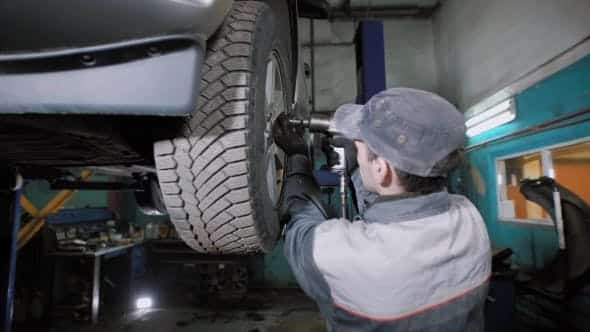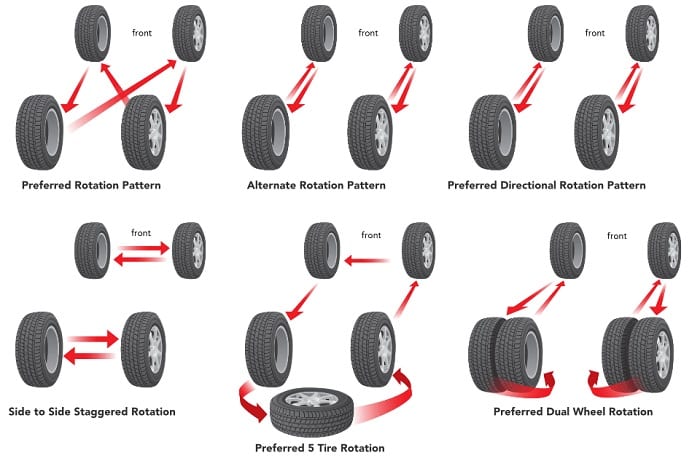Tires are essential to a vehicle for it can support the car’s weight, absorb road shocks, transmit braking forces or most commonly and vitally, keep straight or change car directions. In short, you can’t have a car run without its wheels.
For its importance, having tires in good condition means having yourself a comfortable and safe drive. Thus, take care of your tires by keeping them in checked regularly.
Before finding out what happens if you don’t rotate your tires, please remember never overlook your tire rotation.
Here’s why.
Tire rotation and its benefits

By rotating, obviously, we are not talking about rolling your tires around the axles. Tire rotation means changing the tires to different positions periodically.
With tire rotation, the wear happens evenly to all four wheels, maximizing the life of them. Moreover, it can also help you preserve traction, balance, and maneuverability.
Overall, tire rotation regularly does not only improve your vehicle’s performance and steadiness but also give you the best safety while driving.
Tire rotation is usually the most neglected maintenance work. However, if you don’t do that small task regularly, the tires of your vehicle will wear out unevenly. And the consequences of that are often worse than you can imagine.
The first and foremost reason for uneven tires is that your car has different pressure on the front tires and the rear. The workload and weight are not distributed evenly among the four wheels of your vehicle.
The front tires carry most of the weight as the engine mechanism mounted transversely towards the axle in front, making the front tires wear faster.
Braking or steering is another reason to lead to uneven tires. When you brake, the weight is shifted forward as the vehicles making it stop. Meanwhile, steering the wheels when you’re changing directions makes the tires lean outside. In both cases, the front tires wear out faster than the rear ones.
What Happens If You Don’t Rotate Your Tires?
Uneven tires cause more harm than people usually think of. Here are some consequences that might happen if you don’t rotate the tires regularly.
1. Short lifespan
As it’s hard to drive on uneven tires, your tires will be disposed of more quickly when you don’t rotate it periodically. Tires are not cheap, no one ever likes to change them frequently.
2. High risks
Having uneven tires can expose the driver himself to a lot of danger or unwanted incidents.
Failure to have your tires rotated regularly will also lead to significantly less thread of the front tires, and so, causing the car imbalance. This is much more dangerous to the driver as the vehicle becomes hard to control, especially in those cases of bad weather or wet road.
Moreover, excessive or low-pressure tires can also reduce grip, lessen the stability of the braking mechanism, exposing you to potential dangers along the road.
3. Warranty disqualified
Some tires brands require car owners to have regular tire rotation to keep it qualified for warranty. There is a high chance that your warranty is denied if the tire manufacturer sees no proper maintenances.
Tire rotation patterns

The pattern one uses for tire rotation depends on one’s vehicle’s own preferences, such as the tire type, or whether the vehicle is front-wheel, rear-wheel or all-wheel drive.
Here are some main patterns you might want to follow for your tire rotation.
1. Rearward cross
This pattern can be used for all types of vehicles.
Move the rear tires to the front axle while keeping it on the same side of the vehicle. Meanwhile, move the front tires backward in the opposite sides of the back axle.
2. X-pattern
This pattern is recommended for vehicles with front-wheel drive.
Move all tires diagonally. By this, move the front tires to the opposite sides of the rear axle and the rear tires to the opposite positions in the front axle.
3. Forward cross
This is a popular pattern among the front-wheel-drive vehicles.
In contrast to the rearward cross, move the front tires straight back to the rear axle and move the rear tires to opposite positions in the front axle.
Frequently asked questions
Question: How often should I rotate my tires?
Answer: It is commonly advisable for tires to be rotated after every 5,000 miles of driving. Sometimes it can be up to 8,000 miles. It will depend on your car type.
The car or tire manufacturer usually will recommend you with their own preferred tire rotation guidelines. You can also look for it in your car’s specifications.
Question: How can I know when I should do tire rotation?
Answer: There will be signs from the tires to show you it’s time to have them rotated. You might want to check on some of these signs:
- Uneven wear or one-side wear:
Uneven-wear tires can cause more harm to the driver. If your vehicle’s tires have one of these signs, you’d need to rotate them as soon as possible.
- Vibration from the vehicle
Sometimes when you can feel the unusual vehicle vibration, it is also caused by uneven wear.
- Pressure loss
When you notice one tire loosen up slowly but still faster than others, it is because that tire suffers more pressure than the rest.
Conclusion
For the importance of the tires in one vehicle, you should never overlook the maintenance part for them. Take your time and notice the changes in your tires regularly.
By having the tire rotation done correctly and timely, you do not only improve on the car’s performance but also enhance the safety of your own self. We hope this article helps you to know exactly what happens if you don’t rotate your tires.